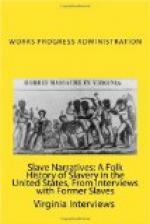“My grandmother brought the meal home and cooked it in a large skillet in a big cake. When it got done, she cut it into slices in the way you would cut up a pie and divided it among us. That all we had to eat.
House
“The white people in those days built their houses back from the front. In South Carolina, there were lots of farms that had four to twelve thousand acres. From what mother told me, Master Bill’s place set back from the road. Then there was a great square place they called the yard. A fence divided the house and the yard adjoining it from that part of the grounds which held the barn. The yard in front and back of the house held a grove.
[Illustration]
The square around the house and the Negro quarters were all enclosed so that the little slaves could not get out while parents were at work. The Negroes assembled on the porch when the gong called them in the morning. The boss gave orders from the porch. There was an open space between the quarters and the court (where the little slaves played). There was a gate between the court and the big house.
“On the rear of the house, there was a porch from which the boss gave orders usually about four o’clock in the morning and at which they would disband in the evening between nine and ten—no certain time but more or less not earlier than nine and not often later than ten. Back of the house and beyond it was a fence extending clear across the yard. In one corner of this fence was a gate leading into the court. Leading out of the court was an opening surrounded by a semi-circular fence which enclosed the Negro quarters.
“The cabins were usually built on the ground—no floors. The roofs were covered with clapboards.
“When I was a boy we used to sing, ’Rather be a nigger than a poor white man.’ Even in slavery they used to sing that. It was the poor white man who was freed by the War, not the Negroes.
Furniture
“There wasn’t any furniture. Beds were built with one post out and the other three sides fastened to the sides of the house.
Marrying Time
“I remember one night the people were gone to marry. That was when all the people in the community married immediately after slavery.
Ghosts
“We had an open fireplace. That was at Bartlett Sanders’ place. He had close on to three thousand acres. Every grown person had gone to the marrying, and I was at home in the bed I just described.




